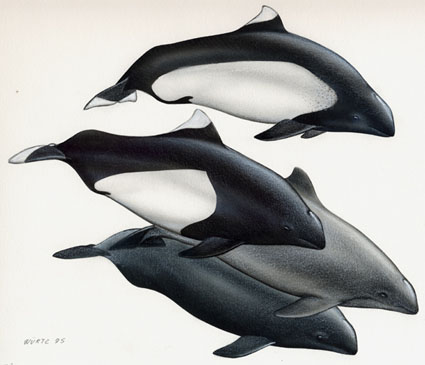Dall's Porpoise (Phocoenoides dalli) - Wiki Dall's Porpoise
From Wikipedia, the free encyclopedia
[Photo] Phocoenoides dalli. Date 2006. Author Alessio Marrucci
Dall's Porpoise (Phocoenoides dalli) is a species of porpoise that came to worldwide attention in the 1970s. It was disclosed for the first time to the public that salmon fishing trawls were killing thousands of Dall's Porpoise and other cetaceans each year by accidentally capturing them in their nets.
The Dall's Porpoise is the only member of the Phocoenoides genus. It was named after American naturalist W.H. Dall.
Physical description
The unique body shape of the Dall's Porpoise makes it easily distinguishable from other cetacean species. The animal has a very thick body and a small head. The colouration is rather like that of an Orca??? the main body of the porpoise is very dark grey to black with very demarcated white patches on the flank that begin some way behind the flippers, which are small and close to the head. The dorsal fin is set just back from the middle of the back and sits up erect. The upper part of the dorsal fin has a white to light grey "frosting". The fluke has a similar frosting. The adult fluke curves back towards the body of the animal, which is another distinguishing feature. It is larger than other porpoises, growing up to 230 cm in length and weighing between 130 and 200 kg. Dall's Porpoises live for up to 15 years.
Population and distribution
Two consistent and well-defined colour morphs??? the dalli-type morph and the truei-type morph have been identified. The dalli-type is more widespread, ranging across the north Pacific Ocean from southern California to southern Japan (including the Sea of Japan in the south up to the Bering Sea in the north). The truei type is more restricted, occupying a smaller area of the northwest Pacific north and east of Japan. The species differs from other porpoises in that it prefers deep water and the open ocean. It may come closer to land. If it does, it typically stays close to deep-water canyons. The population is believed to be common in most of its range and although no precise estimates exist (surveying is hampered by the porpoises' propensity for approaching boats), the global population numbers in at least the hundreds of thousands. (See also 'conservation' below). The greatest concentration is perhaps in the Sea of Okhotsk.
Behavior
Dall's Porpoises are hugely active creatures. They will often zigzag around at great speed on or just below the surface of the water creating a spray called a "rooster tail". They may appear and disappear quite suddenly. The fastest of all small cetaceans, and coming close to matching the mighty Orca for speed, Dall's Porpoises can swim at up to 55 km/h. The porpoises will approach boats and will bow- and stern-ride, but may lose interest, unless the boat is travelling quickly.
Dall's Porpoises appear in small groups (about 2??? 10 in number). The groups appear not to be tight knit and may aggregate together at good feeding grounds. On very rare occasions a thousand or more individual may be seen at the same time. They feed on a variety of fish and cephalopods. Shoals of fish such as herring, anchovies and mackerel are common meals.
Hybrids
Baird et al (1998) determined through DNA sequencing that a fetus found in British Columbia was an intergeneric hybrid of a Dall's Porpoise and a Harbour Porpoise. This hybrid may not be rare??? it may describe the origins of some atypically coloured individuals that otherwise appear to be Dall's Porpoises spotted off the coast of Vancouver Island.
Conservation
Many Dall's Porpoises are killed each year as bycatch in fishing nets. A serious cause of concern is the hunting of Dall's Porpoises by harpoon by Japanese hunters. The number of porpoise killed each year rose dramatically following the moratoria on hunting larger cetaceans introduced in the mid-1980s. 1988 saw the greatest number, 40,000, killed. A quota of 18,000 individuals per year is now in operation. However, concern remains that this is sufficient to deplete populations in the western Pacific.
http://en.wikipedia.org/wiki/Dall%27s_Porpoise
| The text in this page is based on the copyrighted Wikipedia article shown in above URL. It is used under the GNU Free Documentation License. You may redistribute it, verbatim or modified, providing that you comply with the terms of the GFDL. |
